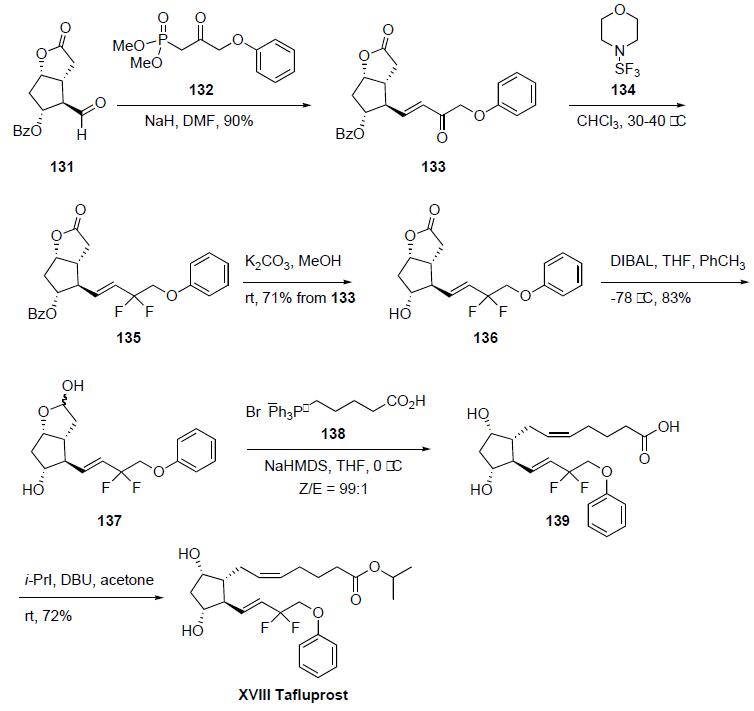|
| | Tafluprost Basic information |
| Product Name: | Tafluprost | | Synonyms: | TAFLUPROST;(5Z)-7-[(1R,2R,3R,5S)-2-[(1E)-3,3-Difluoro-4-phenoxy-1-buten-1-yl]-3,5-dihydroxycyclopentyl]-5-heptenoic acid 1-methylethyl ester;15,15-DIFLUORO-9ALPHA,11ALPHA-DIHYDROXY-16-PHENOXY-17,18,19,20-TETRANOR-PROSTA-5Z,13E-DIEN-1-OIC ACID, ISOPROPYL ESTER;AFP-168;Tafluprost5-Heptenoic acid, 7-[(1R,2R,3R,5S)-2-[(1E)-3,3-difluoro-4-phenoxy-1-buten-1-yl]-3,5-dihydroxycyclopentyl]-,1-methylethyl ester, (5Z)-;He has fluprostaglandin;MK2452;TafL | | CAS: | 209860-87-7 | | MF: | C25H34F2O5 | | MW: | 452.53 | | EINECS: | 234-199-2 | | Product Categories: | | | Mol File: | 209860-87-7.mol |  |
| | Tafluprost Chemical Properties |
| Boiling point | 552.9±50.0 °C(Predicted) | | density | 1.186 | | storage temp. | 2-8°C | | solubility | soluble in Chloroform, DMSO, Ethyl Acetate | | form | Clear, colorless to slightly yellow oil | | pka | 14.48±0.70(Predicted) |
| | Tafluprost Usage And Synthesis |
| Description | Glaucoma is second only to cataracts as a causative factor of blindness.
By 2010, it is estimated that approximately 60 million people worldwide
will be afflicted by glaucoma, so effective treatments should garner a large market.
PG analogs have been widely used for lowering IOP by increasing uveoscleral outflow through agonism of the prostanoid FP
receptor, and currently marketed versions include latanoprost, unoprostone isopropyl ester, bimatoprost, and travoprost.
Compared to the carboxylic acid of latanaprost
(Ki=4.7 nM), the carboxylic acid of tafluprost displayed a 10-fold greater
affinity for the prostanoid FP receptor (Ki=0.4 nM). The synthesis of
tafluprost begins with a Wittig condensation of the protected bicyclic
lactone carbaldehyde with a dimethyl phosphonate ketone derivative.
Compared to the carboxylic acid of latanaprost (Ki 4.7 nM), the carboxylic acid of tafluprost displayed a 10-fold greater affinity for the prostanoid FP receptor (Ki 0.4 nM). The synthesis of tafluprost begins with a Wittig condensation of the protected bicyclic lactone carbaldehyde with a dimethyl phosphonate ketone derivative. The bottom appendage is then completed by the fluorination of the ketone with morpholino-sulfur trifluoride. Hydrolysis of the benzoate ester protecting group liberates the hydroxy group, and reduction of the lactone is accomplished with aluminum hydride to generate the lactol. Condensation of this intermediate with the phosphonium salt of the acid side chain generates the free acid, or active ingredient, which is subsequently esterified with 2-iodopropane in the presence of DBU.
. | | Originator | Santen/Asahi Glass (Japan) | | Uses | Tafluprost is a novel prostanoid used in the treatment of glaucoma and is the first prostanoid to be released in a preservative free-formula. | | Definition | ChEBI: Tafluprost is a prostaglandin Falpha that is prostaglandin F2alpha in which the carboxylic acid function has been converted to the corresponding isopropyl ester and the 3-hydroxy-1-octenyl side-chain is substituted by 3,3-difluoro-4-phenoxybut-1-enyl. Used for treatment of elevated intraocular pressure in patients with open-angle glaucoma or ocular hypertension. It has a role as a prostaglandin receptor agonist. It is a prostaglandins Falpha, an organofluorine compound and an isopropyl ester. It is functionally related to a prostaglandin F2alpha. | | Brand name | Taflotan | | Synthesis | The
synthesis was initiated from the Corey aldehyde 131.
Horner-Emmons condensation of the bicyclic carbaldehyde
131 with the dimethyl phosphonate 132 using NaH in DMF
gave enone 133 in 90% yield. Fluorination of the enone 133
was accomplished upon reaction with morpholino-sulfur
trifluoride (134) in chloroform to yield the corresponding
difluorinated compound 135. Hydrolysis of the benzoate
ester group of 135 with K2CO3 in methanol at room temperature
afforded alcohol 136 in 71% yield from 133. Reduction
of the lactone group of 136 with diisobutyl aluminum hydride
(DIBAL) in THF/toluene gave lactol 137 in 83% yield.
Lactol 137 was condensed with the phosphonium ylide prepared
by deprotonation of phosphonium salt 138 with sodium
bis(trimethylsilyl)amide (NaHMDS) in THF/toluene to
give the prostaglandin F2-alpha derivative 139 in excellent
Z/E selectivity (99:1). The synthesis was completed by esterification
of compound 139 with isopropyl iodide and DBU
in acetone to provide tafluprost (XVIII) in 72% yield. 
| | Mode of action | Tafluprost(209860-87-7) is a Prostaglandin Analog. The mechanism of action of tafluprost is as a Prostaglandin Receptor Agonist. It is believed that prostanoid FP-receptor agonists such as tafluprost reduce IOP by increasing the uveoscleral outflow of aqueous humor. There is some evidence that tafluprost may lower IOP by interaction with the EP3 receptor.
DB08819 |
| | Tafluprost Preparation Products And Raw materials |
|